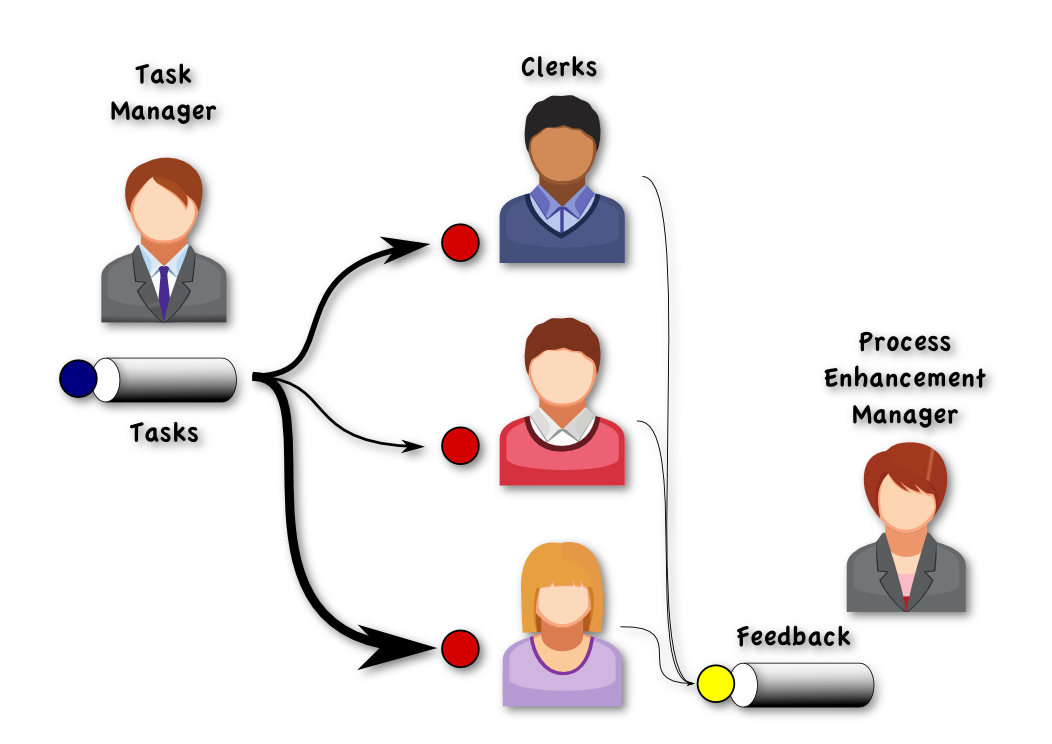In the IT world we have a lot of systems to organize our daily business. Process models tell us how to do our work but what about models for outside IT? How should for example an accountant office organize their workforce and their tasks?
This blog post will introduce a queue based model that emphasizes on process throughput and process enhancements for knowledge workers. It is inspired by Kanban.

The picture above shows a normal workflow. There is a “Task Manager” who manages the queue of incoming work (“Tasks”), there are “Clerks” that do the actual work, and there is a “Process Enhancement Manager” who is responsible to enhance the given processes based on the “Feedback” they get from the normal working procedures.
The clerks can always choose from the most prioritized task. So for getting work it is not necessary to talk to the task manager but might make sense in complicated cases.
Task
A normal service company is executing tasks and charging their customers for the successful finish. All tasks trigger internal processes sometimes they are documented sometimes there aren’t. In a modern company they are documented and they are able to enhance them in a continuous way. A lot of people refer the CMMI® model. Every company in a competitive market must reach Level 5: Optimizing sooner or later or it will be outperformed by more efficient competitors.
In Level 5 the company focuses on process improvement. Process improvement also means to increase throughput and therefore lower operational expenses.
Examples of tasks for an accountant office would be:
- Book bills and receipts
- Prepare tax statements
- Consult customers in special cases
Feedback
An often underestimated step in a company is continuous feedback and evaluation of this feedback. In a modern work environment processes might evolve daily. The process enhancement manager should directly talk to the clerks and always change work orders if there is something to enhance.
Roles
The next paragraphs will elaborate on the given roles in the diagram above and describe their daily work.
Task manager
The task manager is the boss of the clerks. They are in charge of the task queue and have to prioritize the incoming work. They do not have to assign the task to the clerks. The clerks pull them for themselves from the queue.
The task manager needs knowledge about the operational execution and they should be multiplicators of operational knowledge.
Based on the customizability of the executed processes the ratio between managers and clerks can be from 5 to 1 up to 50 to 1. The more standardized the tasks are the more clerks a manager can keep.
Clerks
The clerks do the actual work. They pull the highest prioritized work from the task queue and do the job. During executing they work they can give feedback to the process enhancement manager. Further IT systems normally keep track of the work and are collecting quantitative data for the processes.
In a highly optimized work variants of the processes are executed and optimized using a multi-armed-bandit approach. this is especially important if it is not sure yet if a certain enhancement will be better than before.
Process enhancement manager
The process enhancement manager is responsible for optimizing the process. They have to be process experts, need to read the feedback carefully and need the ability to explain these enhancements to the clerks.
They need statistical skills to check if certain data is just by chance or represents a real enhancement in throughput or quality.
They need good communication skills and their payment should be based on real process enhancements.
Leave a Reply